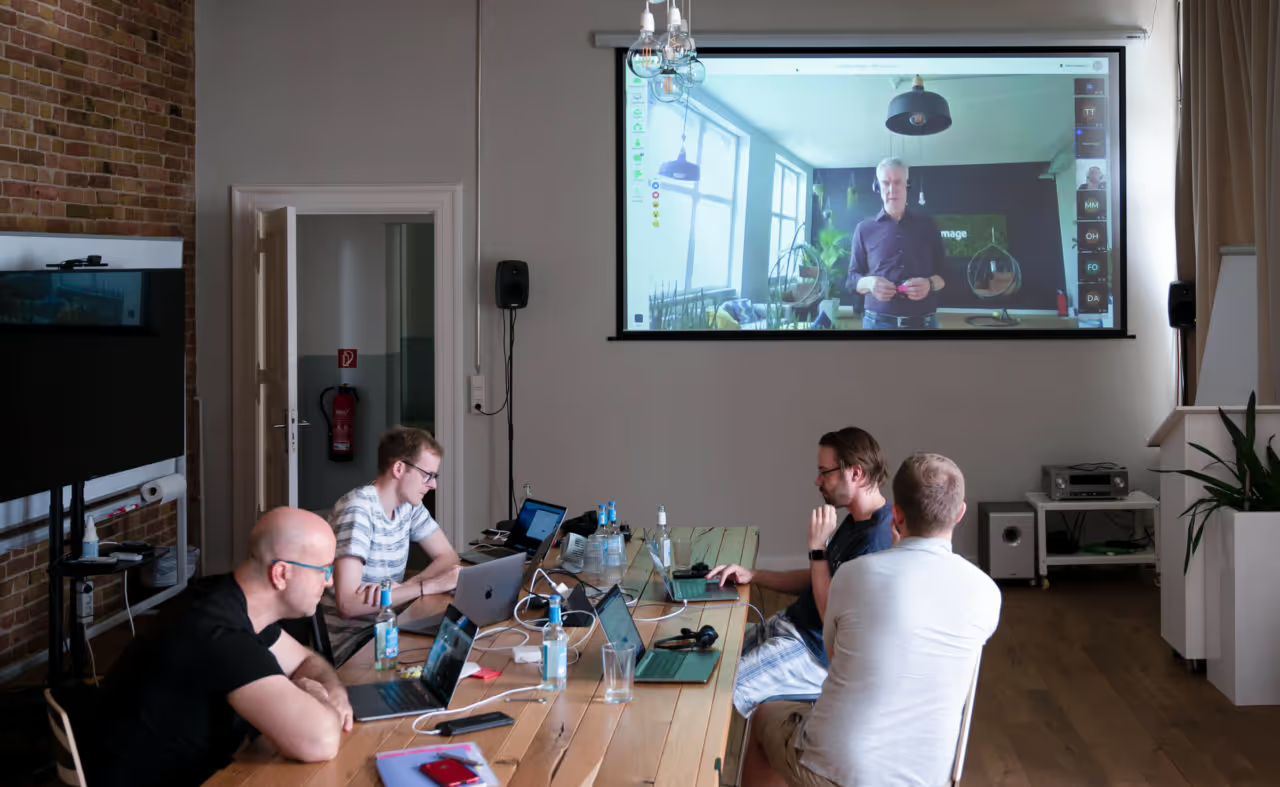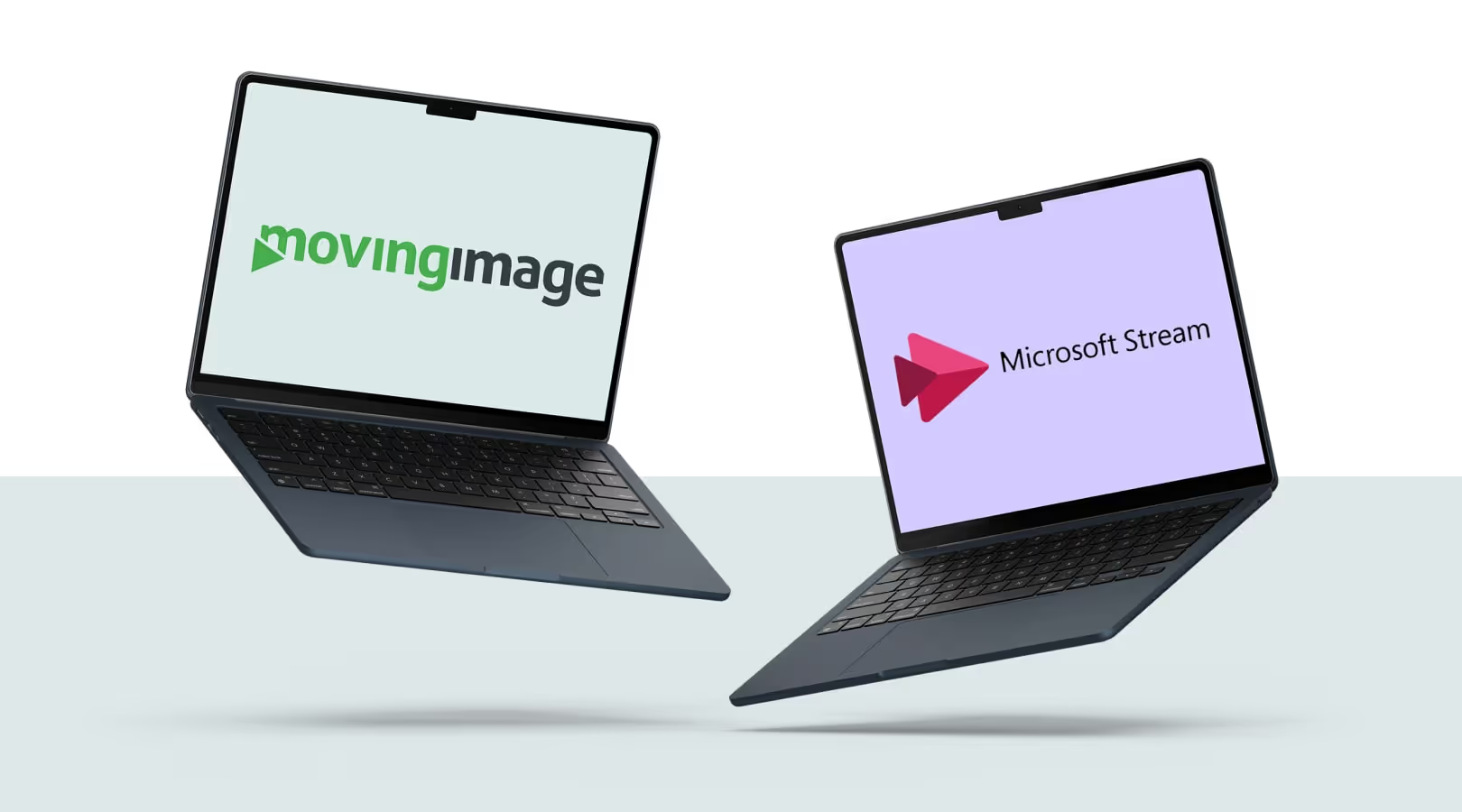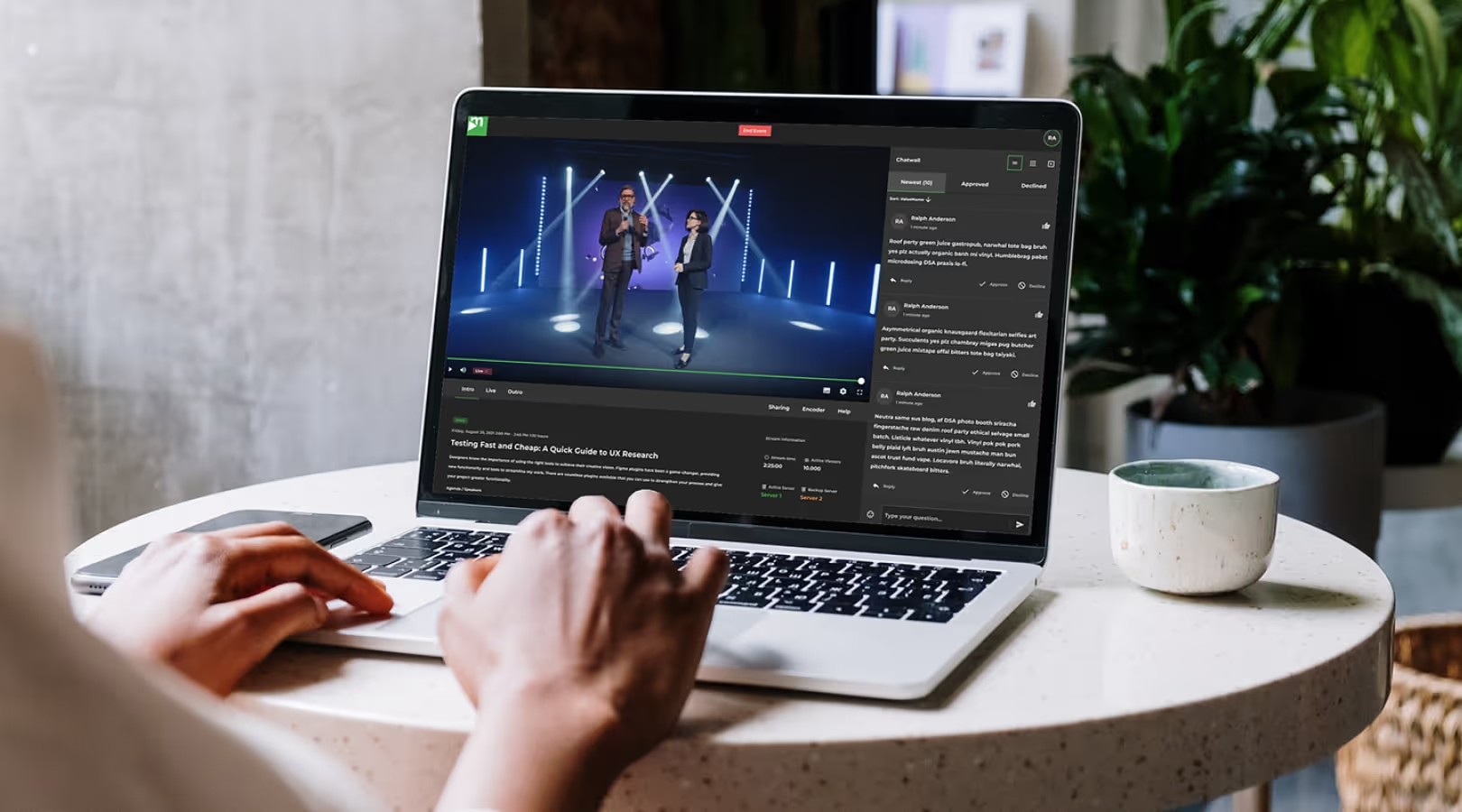Virtual events: planning and execution [2022]

Driving your success with video

Virtual events: planning and execution [2022]
What is a virtual event?
Unlike traditional events where everyone gathers at a physical location, virtual events take place entirely online. Each participant joins from wherever they are—whether it’s at home, in the office, or on the go—using a smartphone or computer.
Virtual events can be public-facing, like online trade shows, conferences, or workshops, or internal, such as virtual town hall meetings, all-hands updates, or digital team-building events.
The COVID-19 pandemic made virtual events a necessity for many businesses and organizers. Along the way, many realized that this format can save both time and money. At first, the abundance of tools and digital event platforms was overwhelming—but today, virtual events have become part of everyday life.
For some, they’re even a welcome change: no travel stress, no commute, just seamless participation from a comfortable environment. That kind of flexibility makes it easier for people to say “yes” to attending in the first place.
How is a virtual event different from an in-person event?

In many ways, virtual and in-person events are quite similar. Both take place at a scheduled time and follow a structured agenda. Both require early planning, and ideally, participants confirm their attendance in advance.
Depending on the number of expected attendees, a virtual event still requires a “venue”—but here’s where the key difference comes in: flexibility.
Without being limited by physical space or capacity, online events allow for much more creative freedom. From the CEO’s living room to a warehouse or a cinematic outdoor stage à la Apple—you choose how to present your event in the most impactful way.
This flexibility also extends to the budget. A small internal workshop streamed from a laptop in someone’s home office is naturally much more cost-effective than a large, choreographed product launch with a full camera crew on a custom-built outdoor stage.
Your attendees benefit, too. Physical limitations like space constraints or distancing and hygiene rules no longer apply. And with a potentially larger audience, you can offer lower ticket prices while reaching more people.
Another plus: virtual events can be recorded and made available on demand after the live session. This is especially useful for repurposing content from webinars, keynotes, and workshops efficiently.
Of course, virtual networking can’t fully replace the spontaneous connections of in-person gatherings. But features like breakout sessions—where smaller groups can meet in separate virtual rooms—can help close the gap.
Some platforms even offer matchmaking features that begin before the event itself. Attendees can set up profiles, view others’ bios, and schedule conversations ahead of time—making networking more intentional and efficient.
One last thing to keep in mind: audience attention spans are often shorter on screen than in person. But with the right event platform, that’s a challenge you can easily overcome. You’ll find more tips on keeping your audience engaged later in this guide.
Examples of virtual events
Virtual live events

Virtual live events are streamed in real time over the internet or an internal network. This means attendees need to be present at a specific time to follow the broadcast. Typically, these events follow a one-to-many format: one host delivers content to a large audience.
To boost engagement, virtual live events can include live chats, polls, audience voting, Q&A sessions, and more—giving attendees the opportunity to actively participate.
Common examples include presentations, product launches, virtual concerts, conferences, employee town halls, and shareholder meetings.
At movingimage, our 2021 User Group Meeting was hosted entirely online. While the event was moderated live from our Berlin office, guest speakers from across Germany joined the stream via live video.
Hybrid events

Hybrid events combine two fundamentally different event formats into one. While the main event takes place on-site in the “real world,” it’s also streamed via the internet or intranet to a remote audience.
Planning a hybrid event requires a special kind of sensitivity—it’s important to create an experience that resonates equally with both in-person and virtual participants. But this format also opens up a whole new range of creative possibilities.
At its core, a hybrid event is a traditional event enhanced with digital technology. It allows organizers to limit the number of attendees on-site if needed, while seamlessly including external participants via livestream.
This concept works especially well for conferences and keynote-style presentations, but it can be adapted to almost any format where an in-person audience adds value.
Attendees benefit from in-person networking, while time and costs can be saved in other areas. That’s why hybrid events are especially popular among companies with multiple office locations.
Before the pandemic, Apple set the gold standard for hybrid events. Their product launches filled auditoriums with journalists, while nearly two million people around the world tuned in to the livestream. The bonus for those attending in person? They got to try out the new devices right after the event—while remote viewers had to wait a few more weeks to pre-order.
On-demand events

Unlike live events, which are streamed in real time, on-demand events are pre-recorded and can usually be accessed anytime, from anywhere.
This format is particularly attractive because it gives a wider audience flexible access to webinars, lectures, and other online sessions—on their own schedule.
On-demand technology is widely used by mid-sized and large companies to maximize reach with relatively little effort.
It’s especially well-suited for webinars and recordings of past events.
What are the advantages of a virtual event?
Online events come with a wide range of benefits. For companies, they’re often more cost-effective thanks to the flexibility in choosing a location—and because there are no travel expenses for attendees. Fewer business trips also mean a smaller carbon footprint, which helps improve your environmental impact.
Virtual events also allow for the use of technologies that might be difficult or expensive to integrate into an in-person event. They’re highly scalable and can be tailored for small groups just as easily as for large global audiences.
Another key advantage: virtual events can go ahead even under travel restrictions or other external limitations. They help protect your participants—without forcing you to compromise on quality or experience.
How much does a virtual event cost?
In most cases, virtual events are significantly more affordable than in-person events—for both organizers and attendees.
Organizers have far more flexibility when it comes to choosing a location. Depending on the type of event, venue costs can be minimal—or even eliminated entirely, especially if the event is streamed from an office or home setting.
Other cost factors, such as catering or on-site security, are also no longer necessary. Technical requirements and related expenses can be much lower as well, depending on the scale and format of the virtual event.
When it comes to potential revenue, virtual events often have the upper hand. A larger maximum number of attendees can lead to more ticket sales and greater overall reach.
And your attendees benefit too: travel and accommodation costs are eliminated, and valuable time is saved. This makes virtual events accessible to participants who might not have been able to attend a physical event at all.
How do you plan a virtual event?
Planning a virtual event requires just as much care and attention as organizing an in-person event. From defining your target audience and developing the concept to coordinating speakers and promoting the event, the planning process is remarkably similar across both formats.
Define your goal
The first step in planning your virtual event is to clearly define its purpose. What do you or your organization want to achieve?
Are you looking to bring all employees together? Generate more leads for your sales team? Sell tickets for revenue—or is your primary goal to deliver valuable content? Maybe it’s a mix of both?
Whatever the objective, your event’s goal will directly influence how it’s planned, executed, and measured. That’s why it’s essential to get this step right from the start.
Define and identify your target audience
Create a clear picture of who you want to reach. Who should attend your event?
Are you organizing a trade show for MedTech startups? Hosting an event for parents of school-aged children? Or launching a new product for a global audience?
The better you define your target audience, the more relevant your content, speaker selection, messaging, and marketing will be.
Also consider how tech-savvy your audience is. Not everyone transitions easily from physical to virtual environments, and your audience’s comfort with digital tools can be a key factor in the success of your event.
For less tech-savvy participants, it’s best to limit the number of platform features and focus on a smooth video stream. Alternatively, be sure to allocate time to explain how any additional tools work.
If your audience is more digitally experienced, interactive features like polls, breakout rooms, or virtual whiteboards can help boost engagement and keep attention levels high.
Choose the right format
Just like in-person events, virtual events come in many shapes and sizes. Your goal is to choose a format that resonates with your target audience and supports your overall objectives.
Webinars, virtual trade shows, and digital product demos all have their unique strengths and limitations—and not every format is suited to every goal. Similarly, not every audience will respond equally well to every type of event.
It’s also important to decide early on whether your event will be purely virtual or hybrid—combining in-person and online participation.
Budget planning
Virtual events still require budget and resources. Whether a virtual event costs more or less than an in-person one depends on many factors—there’s no one-size-fits-all answer. With so many formats and execution options, the total cost ultimately depends on your specific setup.
Some virtual events are more affordable than their physical counterparts—there’s no venue to rent and often less technical equipment is needed. Others may be more expensive, especially if you invest heavily in custom development or a premium user experience.
To plan your budget effectively, consider how much revenue each attendee could generate—whether through ticket sales or by becoming a qualified lead—and how many attendees you expect. This will help you estimate both your potential earnings and your budget range.
Keep in mind that participants are often less willing to pay for a virtual event than a physical one. With in-person events, the value often goes beyond the core content—think catering, after-parties, or live entertainment. If you plan to charge similar prices, you’ll need to offer participants clear added value.
Alternatively, virtual events can be funded through sponsorships and partnerships. In fact, online formats offer valuable data that can be used for marketing retargeting—making them highly attractive to potential sponsors.
When allocating your budget, consider prioritizing the following items:
- Speaker fees
- Compensation for your internal team
- Virtual or hybrid event platform / streaming solution
- Event or streaming location
- Streaming technology (camera(s), microphones, encoders, etc.)
- Additional tools or third-party tech (website, mobile app, VR headsets, virtual whiteboards, green screens, etc.)
- Props or materials specific to your event
- Event marketing and promotion
- Giveaways or thank-you gifts for speakers and attendees
Assemble your event team
Very few events are planned by just one person. Virtual events—like in-person ones—require detailed preparation and often an entire team to execute successfully.
That’s why it’s important to understand the scope and requirements of your event early on and bring in the right support.
For in-person events, the physical venue plays a central role. For virtual events, the focus shifts to the event platform and the quality of the video stream. So your first conversations should be with your internal IT team to clarify the technical landscape and identify the right event platform provider.
Partnering with a professional video agency also ensures that your stream is produced and delivered at a high standard. This is especially crucial for more complex formats—like multi-camera setups or live contributions from remote speakers—where an experienced video team helps ensure everything runs smoothly and stress-free.
Involve your IT team and video agency early in the planning process so you can build a strong technical foundation and avoid last-minute surprises.
To shape your event content, reach out to potential speakers and moderators as early as possible to check availability, align on budget, and begin structuring your agenda.
Support from your marketing and design teams will also be key—especially when it comes to promoting the event and creating branded materials like websites, presentations, emails, and social media posts.
Choose your event solution
With your goals, audience, format, budget, and team in place—it’s time to focus on the technical setup. Depending on your event format and target audience, different tools and platforms may be needed to help you achieve your objectives.
At a minimum, every virtual event is built on a live video stream. Depending on the platform you choose and your specific needs, this can be enhanced with a range of useful features.
To narrow down your options, start by answering a few key questions:
- How many participants are expected?
- Is the event ticketed or otherwise restricted?
- How many speakers or moderators will be joining—and from how many locations?
- Should the audience be able to interact (e.g., via chat, polls, or live voting)?
- Will virtual networking be part of the experience?
- Are breakout sessions planned?
- Will you use additional tools (e.g., virtual whiteboards)?
- Should the event be recorded for on-demand access?
The answers will help you determine which event platforms or tools are the best fit.
In general, most solutions fall into one of three categories:
The virtual event platform
Best suited for: Virtual events of any size where interaction with—and between—participants is essential. Ideal for trade shows, conferences, workshops, webinars, lectures, town hall meetings, corporate updates, shareholder meetings, team-building events, and more.
Example: movingimage Virtual Events
A virtual event platform enables the seamless execution of a wide range of event formats. Organizers benefit from an extensive feature set that simplifies planning and delivery while supporting audience interaction.
Key features of the movingimage event platform include:
- Invitation and registration management
- Moderation tools
- Agenda planning
- White-label branding to match your corporate identity
- Global chats and announcements
- Main stage and breakout rooms
- Networking and matchmaking between attendees
- 1:1 video meetings and chat
- Polls, live voting, Q&A sessions
- Event analytics
- Easy integration of third-party tools (e.g., streaming solutions, whiteboards, polls, etc.)
Advantages of a virtual event platform:
- All essential tools in one place
- Closely replicates the experience of a physical event
- Enables networking even at scale
- Easy event creation—even without IT resources
- Interactive features boost engagement and attention
Disadvantages:
- Costs typically increase with the number of attendees
The live streaming solution
Best suited for: Large-scale virtual events where one or a few presenters are broadcasting to a large audience—and no direct interaction is required. Common use cases include product launches, keynote speeches, and company announcements.
Example: movingimage LiveStream Pro
A professional live streaming solution allows you to broadcast high-quality video and audio to a large audience. In most cases, interaction is limited to a central chat, keeping participants focused on the stream itself.
Advantages of a live streaming solution:
- Highly scalable
- The player can be easily embedded into a website, app, or social media platform
- Simple, optimized integration into existing infrastructure
Disadvantages:
- Little to no interactive functionality
The video conferencing solution
Best suited for: Small virtual events with smaller groups and high levels of interaction between all participants—such as workshops, team meetings, or webinars.
Example: Microsoft Teams
A video conferencing solution allows all participants to transmit video and audio live at the same time. This makes it ideal for smaller events where open, two-way communication is essential. However, for larger groups, this format can quickly become difficult to manage.
Advantages of video conferencing solutions:
- Already available in many organizations
- Simple, distraction-free interaction
Disadvantages:
- Not scalable for large audiences
- Advanced features require third-party integrations
Finalize your content and agenda
For virtual events, content is even more critical than at in-person events. Attendees are more easily distracted when watching from behind a screen, so it’s essential to tailor your content specifically to your audience—and make the most of what the virtual format can offer.
We recommend familiarizing yourself with the features of your chosen virtual event platform as early as possible, and integrating those features directly into your presentations. A well-placed poll or a quick activity on a virtual whiteboard can work wonders for capturing attention.
Even with these digital tools at your disposal, it’s important to plan your agenda more generously than you might for a physical event.
One of the biggest advantages of virtual events is their scalability—you can invite participants from all over the world. This makes it especially important to consider time zones when scheduling sessions.
Also think carefully about the length of your event and each individual session. Attendees need enough breaks to reset their focus, network, or simply stretch their legs and get some fresh air.
We recommend limiting presentations or sessions to 45–60 minutes, and breaking up the agenda with pauses, networking sessions, and interactive elements to keep things fresh and engaging.
Event promotion
Promoting and marketing a digital event doesn’t differ all that much from a traditional event.
Your event website is the central source of information. It should be well-designed, informative, and persuasive. A strong event website typically includes:
- Start time and duration
- Agenda
- Registration links
- Information about the event platform
- Speaker bios
- Sponsor information
To attract attention and drive traffic to your event site, you can rely on proven marketing channels.
Advertising on social media, relevant websites, and in newsletters is an effective way to reach your defined target audience. Collaborate with industry influencers and make sure your booked speakers and sponsors also promote the event within their networks.
A well-maintained, keyword-optimized blog can be a cost-effective and sustainable way to grow your reach. Guest articles and interviews in relevant online publications require more effort—but can yield even greater impact.
Print or TV ads may also be worthwhile, depending on your budget.
In any case, begin promoting your online event early—ideally in parallel with the rest of your planning efforts. Even if you haven’t finalized every detail yet, it’s worth starting the conversation with your audience.
For example, you could begin building your email list ahead of ticket sales, allowing you to keep interested attendees informed and engaged well before the event begins.
Networking at virtual events
For many attendees, networking is just as important as the event content—if not more so. That’s why, when planning a virtual event, organizers should make networking capabilities a key consideration when selecting their event platform.
The movingimage Virtual Events platform, for example, allows participants to connect with one another during the event through public or private chats, dedicated breakout rooms, or even one-on-one video calls with up to four participants.
Attendees can create personal profiles with photos and interests. An integrated matchmaking feature suggests promising networking opportunities and helps participants engage—even without being in the same room.
Depending on the format, you might also consider creating event-specific communities, such as dedicated social media groups, where participants can interact before and after the event.
Whatever approach you choose, make sure networking is a visible and intentional part of your agenda—and give participants time to connect even after the final session wraps up.
How to keep your audience engaged

We’ve mentioned it throughout this guide—and event organizers bring it up again and again: keeping participants engaged during a virtual event can be a real challenge.
Compared to physical events, virtual formats offer far more opportunities for distractions. Attendees can zone out with just one click.
That’s why event planners need to develop new strategies and offer real value to hold the audience’s attention over longer periods.
Here are our top 5 tips to drive engagement and keep your audience tuned in:
1. Stay relevant
Think about it: we have no problem getting fully absorbed in a 90-minute football match or binge-watching three episodes of our favorite Netflix show. So why should a virtual event be any different? You know your audience—use that insight to plan content and sessions that truly resonate.
2. Respect their time
Let’s talk agenda: keep presentations, sessions, and workshops short and to the point. Nothing drains energy faster than a session that drags on unnecessarily. Give attendees that time back with generous breaks throughout the event.
3. Be impressive
Offer your audience something they haven’t seen before. Just because your event is online doesn’t mean it has to feel basic. Use an eye-catching location or professional production quality to elevate the experience. Don’t be afraid to bring in a video production agency to help make it memorable.
4. Encourage interaction
Be proactive and give participants plenty of ways to get involved. From quizzes and polls to Q&As, chat, raffles, breakout rooms, and networking sessions—there are many ways to integrate your audience into the action, with or without their camera on.
5. Choose the right event platform
Even the best event concept can fall flat if the platform doesn’t deliver. Poor video quality, limited features, or technical glitches are among the top reasons for audience drop-off. A reliable, high-quality platform ensures that your content shines.
Our own virtual event solution—movingimage Virtual Events—is the result of years of experience live streaming for Germany’s top enterprises. Designed by true event and streaming professionals, the platform supports virtual events of any size with ease.
Conclusion
Virtual events are far more than a temporary solution born out of the pandemic. Whether fully digital or hosted in a hybrid format, online events are here to stay.
With the right planning, you can take full advantage of new technologies and unlock event formats and experiences that simply aren’t possible in a physical setting.
By following the strategies outlined in this guide, you’ll be well equipped to plan and host impactful virtual events—ones that engage your audience and help you reach your business goals.
Our Speakers
What is a virtual event?
Unlike traditional events where everyone gathers at a physical location, virtual events take place entirely online. Each participant joins from wherever they are—whether it’s at home, in the office, or on the go—using a smartphone or computer.
Virtual events can be public-facing, like online trade shows, conferences, or workshops, or internal, such as virtual town hall meetings, all-hands updates, or digital team-building events.
The COVID-19 pandemic made virtual events a necessity for many businesses and organizers. Along the way, many realized that this format can save both time and money. At first, the abundance of tools and digital event platforms was overwhelming—but today, virtual events have become part of everyday life.
For some, they’re even a welcome change: no travel stress, no commute, just seamless participation from a comfortable environment. That kind of flexibility makes it easier for people to say “yes” to attending in the first place.
How is a virtual event different from an in-person event?

In many ways, virtual and in-person events are quite similar. Both take place at a scheduled time and follow a structured agenda. Both require early planning, and ideally, participants confirm their attendance in advance.
Depending on the number of expected attendees, a virtual event still requires a “venue”—but here’s where the key difference comes in: flexibility.
Without being limited by physical space or capacity, online events allow for much more creative freedom. From the CEO’s living room to a warehouse or a cinematic outdoor stage à la Apple—you choose how to present your event in the most impactful way.
This flexibility also extends to the budget. A small internal workshop streamed from a laptop in someone’s home office is naturally much more cost-effective than a large, choreographed product launch with a full camera crew on a custom-built outdoor stage.
Your attendees benefit, too. Physical limitations like space constraints or distancing and hygiene rules no longer apply. And with a potentially larger audience, you can offer lower ticket prices while reaching more people.
Another plus: virtual events can be recorded and made available on demand after the live session. This is especially useful for repurposing content from webinars, keynotes, and workshops efficiently.
Of course, virtual networking can’t fully replace the spontaneous connections of in-person gatherings. But features like breakout sessions—where smaller groups can meet in separate virtual rooms—can help close the gap.
Some platforms even offer matchmaking features that begin before the event itself. Attendees can set up profiles, view others’ bios, and schedule conversations ahead of time—making networking more intentional and efficient.
One last thing to keep in mind: audience attention spans are often shorter on screen than in person. But with the right event platform, that’s a challenge you can easily overcome. You’ll find more tips on keeping your audience engaged later in this guide.
Examples of virtual events
Virtual live events

Virtual live events are streamed in real time over the internet or an internal network. This means attendees need to be present at a specific time to follow the broadcast. Typically, these events follow a one-to-many format: one host delivers content to a large audience.
To boost engagement, virtual live events can include live chats, polls, audience voting, Q&A sessions, and more—giving attendees the opportunity to actively participate.
Common examples include presentations, product launches, virtual concerts, conferences, employee town halls, and shareholder meetings.
At movingimage, our 2021 User Group Meeting was hosted entirely online. While the event was moderated live from our Berlin office, guest speakers from across Germany joined the stream via live video.
Hybrid events

Hybrid events combine two fundamentally different event formats into one. While the main event takes place on-site in the “real world,” it’s also streamed via the internet or intranet to a remote audience.
Planning a hybrid event requires a special kind of sensitivity—it’s important to create an experience that resonates equally with both in-person and virtual participants. But this format also opens up a whole new range of creative possibilities.
At its core, a hybrid event is a traditional event enhanced with digital technology. It allows organizers to limit the number of attendees on-site if needed, while seamlessly including external participants via livestream.
This concept works especially well for conferences and keynote-style presentations, but it can be adapted to almost any format where an in-person audience adds value.
Attendees benefit from in-person networking, while time and costs can be saved in other areas. That’s why hybrid events are especially popular among companies with multiple office locations.
Before the pandemic, Apple set the gold standard for hybrid events. Their product launches filled auditoriums with journalists, while nearly two million people around the world tuned in to the livestream. The bonus for those attending in person? They got to try out the new devices right after the event—while remote viewers had to wait a few more weeks to pre-order.
On-demand events

Unlike live events, which are streamed in real time, on-demand events are pre-recorded and can usually be accessed anytime, from anywhere.
This format is particularly attractive because it gives a wider audience flexible access to webinars, lectures, and other online sessions—on their own schedule.
On-demand technology is widely used by mid-sized and large companies to maximize reach with relatively little effort.
It’s especially well-suited for webinars and recordings of past events.
What are the advantages of a virtual event?
Online events come with a wide range of benefits. For companies, they’re often more cost-effective thanks to the flexibility in choosing a location—and because there are no travel expenses for attendees. Fewer business trips also mean a smaller carbon footprint, which helps improve your environmental impact.
Virtual events also allow for the use of technologies that might be difficult or expensive to integrate into an in-person event. They’re highly scalable and can be tailored for small groups just as easily as for large global audiences.
Another key advantage: virtual events can go ahead even under travel restrictions or other external limitations. They help protect your participants—without forcing you to compromise on quality or experience.
How much does a virtual event cost?
In most cases, virtual events are significantly more affordable than in-person events—for both organizers and attendees.
Organizers have far more flexibility when it comes to choosing a location. Depending on the type of event, venue costs can be minimal—or even eliminated entirely, especially if the event is streamed from an office or home setting.
Other cost factors, such as catering or on-site security, are also no longer necessary. Technical requirements and related expenses can be much lower as well, depending on the scale and format of the virtual event.
When it comes to potential revenue, virtual events often have the upper hand. A larger maximum number of attendees can lead to more ticket sales and greater overall reach.
And your attendees benefit too: travel and accommodation costs are eliminated, and valuable time is saved. This makes virtual events accessible to participants who might not have been able to attend a physical event at all.
How do you plan a virtual event?
Planning a virtual event requires just as much care and attention as organizing an in-person event. From defining your target audience and developing the concept to coordinating speakers and promoting the event, the planning process is remarkably similar across both formats.
Define your goal
The first step in planning your virtual event is to clearly define its purpose. What do you or your organization want to achieve?
Are you looking to bring all employees together? Generate more leads for your sales team? Sell tickets for revenue—or is your primary goal to deliver valuable content? Maybe it’s a mix of both?
Whatever the objective, your event’s goal will directly influence how it’s planned, executed, and measured. That’s why it’s essential to get this step right from the start.
Define and identify your target audience
Create a clear picture of who you want to reach. Who should attend your event?
Are you organizing a trade show for MedTech startups? Hosting an event for parents of school-aged children? Or launching a new product for a global audience?
The better you define your target audience, the more relevant your content, speaker selection, messaging, and marketing will be.
Also consider how tech-savvy your audience is. Not everyone transitions easily from physical to virtual environments, and your audience’s comfort with digital tools can be a key factor in the success of your event.
For less tech-savvy participants, it’s best to limit the number of platform features and focus on a smooth video stream. Alternatively, be sure to allocate time to explain how any additional tools work.
If your audience is more digitally experienced, interactive features like polls, breakout rooms, or virtual whiteboards can help boost engagement and keep attention levels high.
Choose the right format
Just like in-person events, virtual events come in many shapes and sizes. Your goal is to choose a format that resonates with your target audience and supports your overall objectives.
Webinars, virtual trade shows, and digital product demos all have their unique strengths and limitations—and not every format is suited to every goal. Similarly, not every audience will respond equally well to every type of event.
It’s also important to decide early on whether your event will be purely virtual or hybrid—combining in-person and online participation.
Budget planning
Virtual events still require budget and resources. Whether a virtual event costs more or less than an in-person one depends on many factors—there’s no one-size-fits-all answer. With so many formats and execution options, the total cost ultimately depends on your specific setup.
Some virtual events are more affordable than their physical counterparts—there’s no venue to rent and often less technical equipment is needed. Others may be more expensive, especially if you invest heavily in custom development or a premium user experience.
To plan your budget effectively, consider how much revenue each attendee could generate—whether through ticket sales or by becoming a qualified lead—and how many attendees you expect. This will help you estimate both your potential earnings and your budget range.
Keep in mind that participants are often less willing to pay for a virtual event than a physical one. With in-person events, the value often goes beyond the core content—think catering, after-parties, or live entertainment. If you plan to charge similar prices, you’ll need to offer participants clear added value.
Alternatively, virtual events can be funded through sponsorships and partnerships. In fact, online formats offer valuable data that can be used for marketing retargeting—making them highly attractive to potential sponsors.
When allocating your budget, consider prioritizing the following items:
- Speaker fees
- Compensation for your internal team
- Virtual or hybrid event platform / streaming solution
- Event or streaming location
- Streaming technology (camera(s), microphones, encoders, etc.)
- Additional tools or third-party tech (website, mobile app, VR headsets, virtual whiteboards, green screens, etc.)
- Props or materials specific to your event
- Event marketing and promotion
- Giveaways or thank-you gifts for speakers and attendees
Assemble your event team
Very few events are planned by just one person. Virtual events—like in-person ones—require detailed preparation and often an entire team to execute successfully.
That’s why it’s important to understand the scope and requirements of your event early on and bring in the right support.
For in-person events, the physical venue plays a central role. For virtual events, the focus shifts to the event platform and the quality of the video stream. So your first conversations should be with your internal IT team to clarify the technical landscape and identify the right event platform provider.
Partnering with a professional video agency also ensures that your stream is produced and delivered at a high standard. This is especially crucial for more complex formats—like multi-camera setups or live contributions from remote speakers—where an experienced video team helps ensure everything runs smoothly and stress-free.
Involve your IT team and video agency early in the planning process so you can build a strong technical foundation and avoid last-minute surprises.
To shape your event content, reach out to potential speakers and moderators as early as possible to check availability, align on budget, and begin structuring your agenda.
Support from your marketing and design teams will also be key—especially when it comes to promoting the event and creating branded materials like websites, presentations, emails, and social media posts.
Choose your event solution
With your goals, audience, format, budget, and team in place—it’s time to focus on the technical setup. Depending on your event format and target audience, different tools and platforms may be needed to help you achieve your objectives.
At a minimum, every virtual event is built on a live video stream. Depending on the platform you choose and your specific needs, this can be enhanced with a range of useful features.
To narrow down your options, start by answering a few key questions:
- How many participants are expected?
- Is the event ticketed or otherwise restricted?
- How many speakers or moderators will be joining—and from how many locations?
- Should the audience be able to interact (e.g., via chat, polls, or live voting)?
- Will virtual networking be part of the experience?
- Are breakout sessions planned?
- Will you use additional tools (e.g., virtual whiteboards)?
- Should the event be recorded for on-demand access?
The answers will help you determine which event platforms or tools are the best fit.
In general, most solutions fall into one of three categories:
The virtual event platform
Best suited for: Virtual events of any size where interaction with—and between—participants is essential. Ideal for trade shows, conferences, workshops, webinars, lectures, town hall meetings, corporate updates, shareholder meetings, team-building events, and more.
Example: movingimage Virtual Events
A virtual event platform enables the seamless execution of a wide range of event formats. Organizers benefit from an extensive feature set that simplifies planning and delivery while supporting audience interaction.
Key features of the movingimage event platform include:
- Invitation and registration management
- Moderation tools
- Agenda planning
- White-label branding to match your corporate identity
- Global chats and announcements
- Main stage and breakout rooms
- Networking and matchmaking between attendees
- 1:1 video meetings and chat
- Polls, live voting, Q&A sessions
- Event analytics
- Easy integration of third-party tools (e.g., streaming solutions, whiteboards, polls, etc.)
Advantages of a virtual event platform:
- All essential tools in one place
- Closely replicates the experience of a physical event
- Enables networking even at scale
- Easy event creation—even without IT resources
- Interactive features boost engagement and attention
Disadvantages:
- Costs typically increase with the number of attendees
The live streaming solution
Best suited for: Large-scale virtual events where one or a few presenters are broadcasting to a large audience—and no direct interaction is required. Common use cases include product launches, keynote speeches, and company announcements.
Example: movingimage LiveStream Pro
A professional live streaming solution allows you to broadcast high-quality video and audio to a large audience. In most cases, interaction is limited to a central chat, keeping participants focused on the stream itself.
Advantages of a live streaming solution:
- Highly scalable
- The player can be easily embedded into a website, app, or social media platform
- Simple, optimized integration into existing infrastructure
Disadvantages:
- Little to no interactive functionality
The video conferencing solution
Best suited for: Small virtual events with smaller groups and high levels of interaction between all participants—such as workshops, team meetings, or webinars.
Example: Microsoft Teams
A video conferencing solution allows all participants to transmit video and audio live at the same time. This makes it ideal for smaller events where open, two-way communication is essential. However, for larger groups, this format can quickly become difficult to manage.
Advantages of video conferencing solutions:
- Already available in many organizations
- Simple, distraction-free interaction
Disadvantages:
- Not scalable for large audiences
- Advanced features require third-party integrations
Finalize your content and agenda
For virtual events, content is even more critical than at in-person events. Attendees are more easily distracted when watching from behind a screen, so it’s essential to tailor your content specifically to your audience—and make the most of what the virtual format can offer.
We recommend familiarizing yourself with the features of your chosen virtual event platform as early as possible, and integrating those features directly into your presentations. A well-placed poll or a quick activity on a virtual whiteboard can work wonders for capturing attention.
Even with these digital tools at your disposal, it’s important to plan your agenda more generously than you might for a physical event.
One of the biggest advantages of virtual events is their scalability—you can invite participants from all over the world. This makes it especially important to consider time zones when scheduling sessions.
Also think carefully about the length of your event and each individual session. Attendees need enough breaks to reset their focus, network, or simply stretch their legs and get some fresh air.
We recommend limiting presentations or sessions to 45–60 minutes, and breaking up the agenda with pauses, networking sessions, and interactive elements to keep things fresh and engaging.
Event promotion
Promoting and marketing a digital event doesn’t differ all that much from a traditional event.
Your event website is the central source of information. It should be well-designed, informative, and persuasive. A strong event website typically includes:
- Start time and duration
- Agenda
- Registration links
- Information about the event platform
- Speaker bios
- Sponsor information
To attract attention and drive traffic to your event site, you can rely on proven marketing channels.
Advertising on social media, relevant websites, and in newsletters is an effective way to reach your defined target audience. Collaborate with industry influencers and make sure your booked speakers and sponsors also promote the event within their networks.
A well-maintained, keyword-optimized blog can be a cost-effective and sustainable way to grow your reach. Guest articles and interviews in relevant online publications require more effort—but can yield even greater impact.
Print or TV ads may also be worthwhile, depending on your budget.
In any case, begin promoting your online event early—ideally in parallel with the rest of your planning efforts. Even if you haven’t finalized every detail yet, it’s worth starting the conversation with your audience.
For example, you could begin building your email list ahead of ticket sales, allowing you to keep interested attendees informed and engaged well before the event begins.
Networking at virtual events
For many attendees, networking is just as important as the event content—if not more so. That’s why, when planning a virtual event, organizers should make networking capabilities a key consideration when selecting their event platform.
The movingimage Virtual Events platform, for example, allows participants to connect with one another during the event through public or private chats, dedicated breakout rooms, or even one-on-one video calls with up to four participants.
Attendees can create personal profiles with photos and interests. An integrated matchmaking feature suggests promising networking opportunities and helps participants engage—even without being in the same room.
Depending on the format, you might also consider creating event-specific communities, such as dedicated social media groups, where participants can interact before and after the event.
Whatever approach you choose, make sure networking is a visible and intentional part of your agenda—and give participants time to connect even after the final session wraps up.
How to keep your audience engaged

We’ve mentioned it throughout this guide—and event organizers bring it up again and again: keeping participants engaged during a virtual event can be a real challenge.
Compared to physical events, virtual formats offer far more opportunities for distractions. Attendees can zone out with just one click.
That’s why event planners need to develop new strategies and offer real value to hold the audience’s attention over longer periods.
Here are our top 5 tips to drive engagement and keep your audience tuned in:
1. Stay relevant
Think about it: we have no problem getting fully absorbed in a 90-minute football match or binge-watching three episodes of our favorite Netflix show. So why should a virtual event be any different? You know your audience—use that insight to plan content and sessions that truly resonate.
2. Respect their time
Let’s talk agenda: keep presentations, sessions, and workshops short and to the point. Nothing drains energy faster than a session that drags on unnecessarily. Give attendees that time back with generous breaks throughout the event.
3. Be impressive
Offer your audience something they haven’t seen before. Just because your event is online doesn’t mean it has to feel basic. Use an eye-catching location or professional production quality to elevate the experience. Don’t be afraid to bring in a video production agency to help make it memorable.
4. Encourage interaction
Be proactive and give participants plenty of ways to get involved. From quizzes and polls to Q&As, chat, raffles, breakout rooms, and networking sessions—there are many ways to integrate your audience into the action, with or without their camera on.
5. Choose the right event platform
Even the best event concept can fall flat if the platform doesn’t deliver. Poor video quality, limited features, or technical glitches are among the top reasons for audience drop-off. A reliable, high-quality platform ensures that your content shines.
Our own virtual event solution—movingimage Virtual Events—is the result of years of experience live streaming for Germany’s top enterprises. Designed by true event and streaming professionals, the platform supports virtual events of any size with ease.
Conclusion
Virtual events are far more than a temporary solution born out of the pandemic. Whether fully digital or hosted in a hybrid format, online events are here to stay.
With the right planning, you can take full advantage of new technologies and unlock event formats and experiences that simply aren’t possible in a physical setting.
By following the strategies outlined in this guide, you’ll be well equipped to plan and host impactful virtual events—ones that engage your audience and help you reach your business goals.



.avif)


.avif)






.avif)





